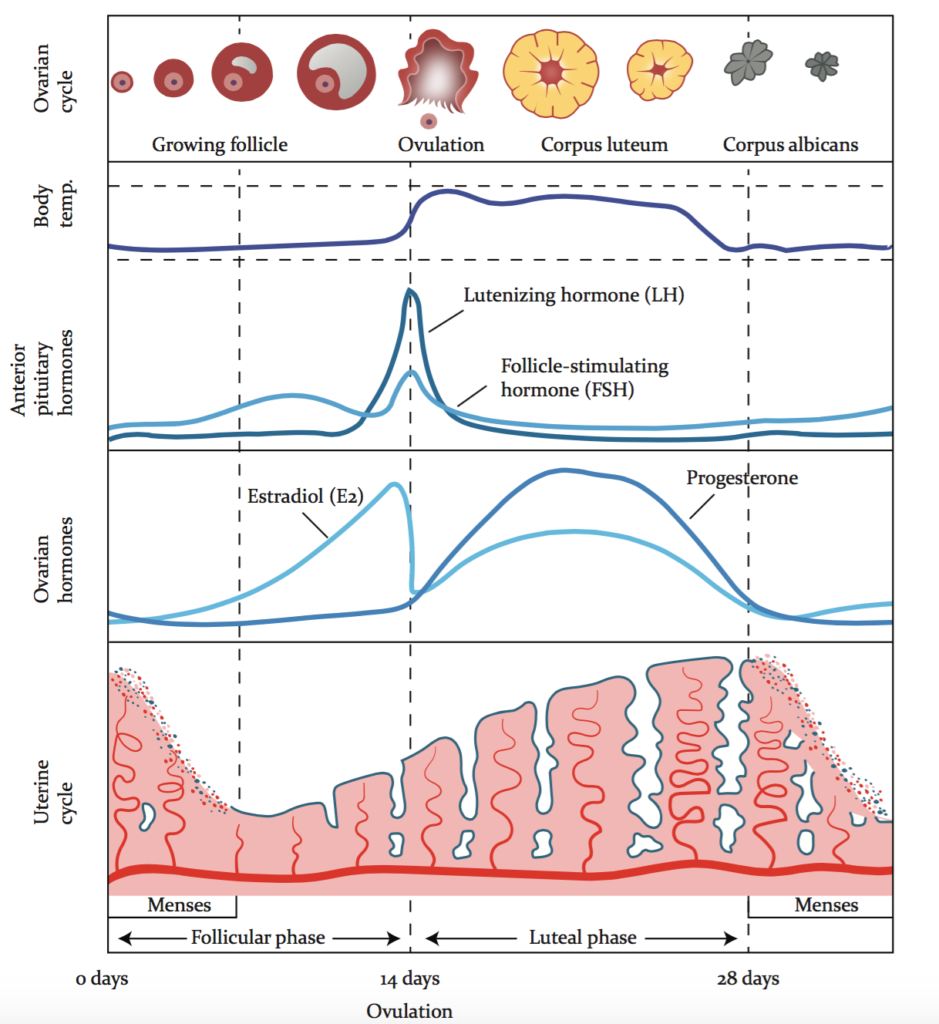In order for individuals born with a uterus and ovaries to have the potential to become pregnant, they must have timely and adequate hormone stimulation during their menstrual cycle to develop a mature egg, release that egg through ovulation, and prepare the uterus for implantation should fertilization occur. The graphic below illustrates the changes in a person’s body during the menstrual cycle.

During a menstrual cycle, both the uterus and ovaries go through changes that are stimulated by chemical signals in our bloodstream called hormones. Hormones from the brain called FSH (follicle stimulating hormone) and LH (luteinizing hormone) are secreted at various times of the menstrual cycle to stimulate the ovaries to mature an egg and trigger ovulation. Hormones from the ovary, called estrogen and progesterone, stimulate the uterus to grow and shed the inside lining of the uterus, during which we have our periods.
The menstrual cycle consists of several phases which overlap and interplay with each other: menstruation, the follicular phase, ovulation, and the luteal phase. The first day of bleeding during a period signals the start of the menstrual cycle. The menstrual cycle then ends when the next period begins. During the first half of the menstrual cycle, called the follicular phase, two things occur: the uterus sheds its lining and we have a period and the ovaries get hormone stimulation to mature an egg from the antral follicle. Once ovulation occurs, the 2nd half of the menstrual cycle, called the luteal phase begins. During the luteal phase, two things occur: hormones stimulate growth of the inside lining of the uterus in preparation for pregnancy should fertilization occu and the antral follicle involutes and becomes something called a corpus luteum which then secretes progesterone.
If after ovulation fertilization occurs, the fertilized egg then travels down the fallopian tube and implants in the uterine lining, and the corpus luteum continues to secrete progesterone which supports the pregnancy. If fertilization does not occur, the egg exits the uterus and the corpus luteum becomes a corpus albicans which causes a drop in progesterone, which then triggers shedding of the uterine lining resulting in a period. Each term is explained in the following glossary.
Glossary
Follicle Development
- Primordial Follicle: A resting follicle that holds an immature egg.
- Primary Follicle: A follicle that has grown to .1mm in diameter.
- Secondary Follicle: A follicle that has developed a fully grown egg and is .2mm in diameter (note: not all follicles contain an egg).
- Preantral Follicle: A follicle that is approximately .2-5mm in diameter.
- Antral Follicle: A follicle that is approximately 10-20mm in diameter.
Ovulation: When the ovaries release a mature egg that is ready for fertilization.
Corpus Luteum: Forms from the ruptured follicle after ovulation and helps prepare the uterus for implantation.
Corpus Albicans: Forms from the breakdown of the corpus luteum when fertilization of the egg does not occur.
Basal Body Temperature (BBT): The body temperature at rest taken in the morning before arising from bed that can be used to help identify the time or presence of ovulation.
ANTERIOR PITUITARY HORMONES
Follicle Stimulating Hormone (FSH): A hormone released from the brain that causes follicles in the ovaries to grow.
Luteinizing Hormone: A hormone released from the brain that triggers ovulation.
OVARIAN HORMONES
Estrogen (Estradiol, E2): A hormone produced primarily in a woman’s ovaries that helps regulate ovulation and uterine lining development.
Progesterone: A hormone that is produced by a woman’s ovaries or a medication that prepares the uterine lining for implantation.
UTERINE CYCLE
Menses: The discharge of blood and other tissue after ovulation when fertilization does not occur.
Follicular Phase: The first phase of the menstrual cycle, from onset of menses to ovulation, in which ovarian follicular growth occurs, in response to hormones. This phase is variable in length in women, but on average lasts approximately 14 days.
Luteal Phase: The second phase of the menstrual cycle beginning from ovulation until the onset of menses. It is associated with hormones that facilitates implantation of the embryo(s) and supports early pregnancy. This phase is typically 12-14 days in all patients.
Learn more by following Kindbody on Instagram where our doctors often share about all things fertility and family-building.